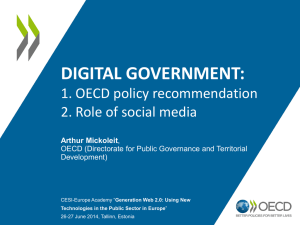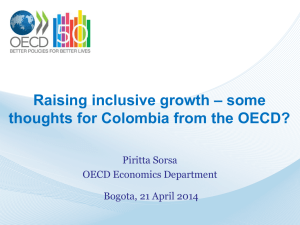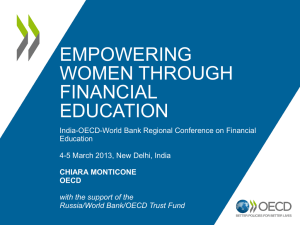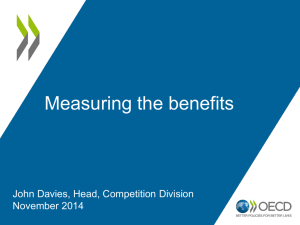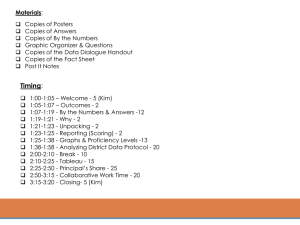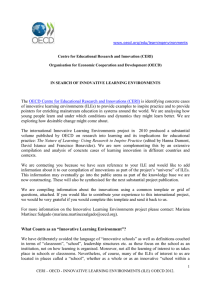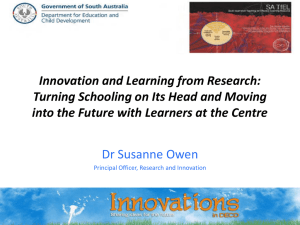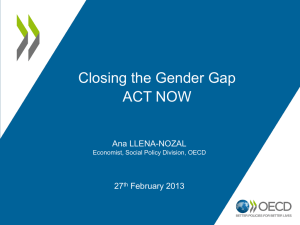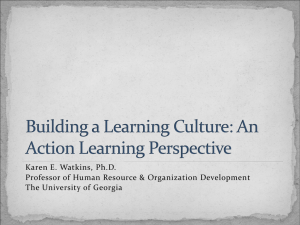David Istance - OECD
advertisement
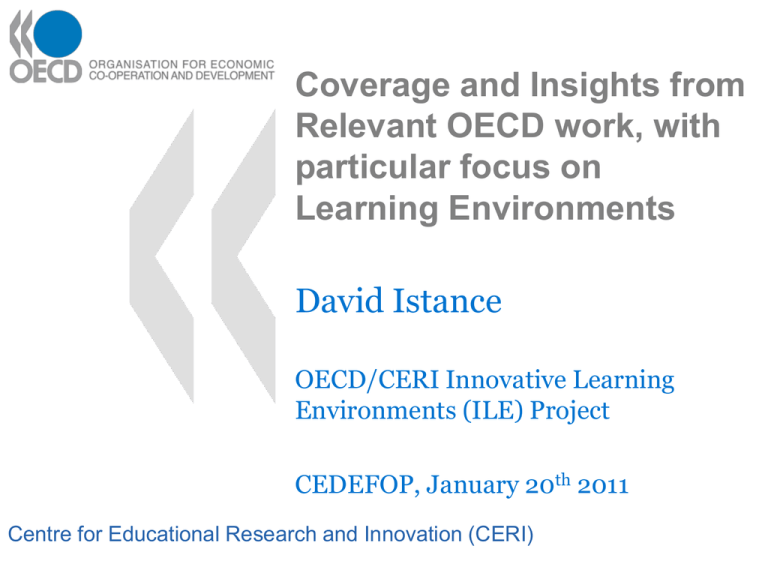
Coverage and Insights from Relevant OECD work, with particular focus on Learning Environments David Istance OECD/CERI Innovative Learning Environments (ILE) Project CEDEFOP, January 20th 2011 Centre for Educational Research and Innovation (CERI) Outline of the Presentation Presentation in two parts: • Insights from the OECD analysis of learning environments • Connection to some of the relevant OECD work – observations and developments INSIGHTS ABOUT EFFECTIVE LEARNING ENVIRONMENTS FROM ILE WORK Why such interest in learning? • Our societies and economies have transformed with knowledge central. Therefore, learning is also central. • Strong focus and advance in measuring learning outcomes, including through PISA. But then how to change outcomes? Focus back on learning (and teaching). • Education has been reformed endlessly - the sense of reaching the limits of educational reform invites a fresh focus on learning itself. • The rapid development and ubiquity of ICT are re-setting the boundaries of educational possibilities but this has not yet revolutionised learning environments on a wide scale. Might it? • The research base on learning grows but so far a “great disconnect” to policy and practice. How to be more ‘evidence-based’? • ‘Innovation’ because meeting the evidence-based criteria of effective learning (next) will call for a substantial endeavour of innovation and change. . OECD/CERI project “Innovative Learning Environments” ILE aims to inform reform and practice through generating analysis of different, innovative and inspiring configurations of learning for children and young people, by: 1. Absorbing the Lessons of Learning Research Effectiveness of Learning Environments – international research 2. Compiling & Analysing Innovative Configurations of Learning Innovations reconfiguring the Learning Environment: the compilation of innovative cases, some in schools, others non-formal, or mixes 3. Facing the Challenge of Implementation Events with stakeholders in participating systems; analysis of how to realise conclusions from 1) and 2) “The Nature of Learning: Using Research to Inspire Practice” OECD Publications, Sept. 2010, 338pp. 1.Analysing & Designing Learning Environments for the 21st Century OECD (Hanna Dumont & David Istance) 2. Historical Developments in the Understanding of Learning Erik De Corte 3. The Cognitive Perspective on Learning Elsbeth Stern & Michael Schneider 4. The Crucial Role of Emotions & Motivation in Learning Monique Boekaerts 5. Developmental & Biological Bases of Learning Cristina Hinton & Kurt Fischer 6. Formative Assessment Dylan Wiliam 7. Technology and Learning Richard Mayer 8. Cooperative Learning & Group-work Robert Slavin 9. Inquiry-based Learning Brigid Barron & Linda Darling-Hammond, 10. The Community and Academic Service Learning Andrew Furco 11. The Effects of Family on Learning Barbara Schneider, Keesler & Morlock 12. Implementing Innovation: from visions to everyday practice Lauren Resnick, James Spillane, Goldman & Rangel 13. Future Directions OECD (Istance & Dumont) ’Nature of Learning’ transversal conclusions To promote learning, environments should: • Make learning central, encourage engagement, and be where learners come to understand themselves as learners • Ensure that learning is social and often collaborative • Be highly attuned to learners’ motivations and the importance of emotions • Be acutely sensitive to individual differences including in prior knowledge • Be demanding for each learner but without excessive overload • Use assessments consistent with its aims, with strong emphasis on formative feedback • Promote horizontal connectedness across activities and subjects, in- and out-of-school Expressed in educational terms… The ‘principles’ mean that learning environments should be: • Learner-centred: highly focused on learning but not as an alternative to the key role for teachers • Structured and well-designed: needs careful design and high professionalism alongside inquiry & autonomous learning • Profoundly personalised: acutely sensitive to individual and group differences and offering tailored feedback • Inclusive: such sensitivity to individual and group differences means they are fundamentally inclusive • Social: learning is effective in group settings, when learners collaborate, and when there is a connection to community. Looking at and analysing real innovative learning environments The OECD project is building: • A Universe of ILEs from as many countries and sources as possible (100+ cases so far), all meeting ILE project criteria – being built in 2009 – 2011 An Inventory (around 35 so far) from those submitted by participating systems to ‘universe’ – more detailed reporting & analysis (2010 and 2011) Substantial international interest and participation • Many countries/regions/organisations have joined and others still considering; ‘joining’ means to take an active role in the ‘Innovation’ and ‘Implementation’ strands of ILE • Austria, Chile, Denmark, Finland, Hungary, Israel, Korea, Mexico, Norway, Portugal, Sweden, Slovenia, Spain • Victoria, South Australia (Australia), Alberta, British Columbia (Canada), Thüringen (Germany), Nuevo Leon (Mexico), Bern & Ticino (Switzerland), Scotland (UK), Ohio (US); Hong Kong, China • ENSI (Environment and School Initiatives), NZ (Cognition Institute), Stupski and Nellie Mae Educational Foundations (US). Others? SOME RELATED OECD WORK – DEVELOPMENTS, INSIGHTS Shift from curriculum analysis… • Handbook of Curriculum Development (1975) • Curriculum Reform: An Overview of Trends (1990) • The Curriculum Redefined: Schooling for the 21st Century (1994) • Making the Curriculum Work (1997) • Plus studies on e.g. school-based curriculum, science curricula, environmental studies …to measuring outcomes PISA surveys, triennially since 2000. Most recently (December 2010) publication of five volumes: • 1. What Students Know and Can Do: Student Performance in Reading, Mathematics and Science • 2. Overcoming Social Background: Equity in Learning Opportunities and Outcomes • 3. Learning to Learn: Student Engagement, Strategies, and Practices • 4. What makes a School Successful? Resources, Policies and Practices • 5. Learning Trends: Changes in Student Performance since 2000 PIAAC (first publication, 2013) and AHELO (feasibility study) 21st Century Skills and Competences The notion of “21st century competences” has appeared increasingly in OECD work e.g.: • The competences measured by the big surveys • Work under the New Millennium Learner umbrella OECD Review on Evaluation and Assessment Frameworks for Improving School Outcomes Began in 2009, to explore how systems of evaluation and assessment can be used to improve the quality, equity and efficiency of school education. Several key objectives: • Synthesise research-based evidence on the impact of evaluation and assessment strategies and disseminate this knowledge among countries • Identify innovative and successful policy initiatives and practices • Facilitate exchanges of lessons and experiences among countries • Identify policy options for policy makers to consider Lifelong and adult learning? • • • • In general, less OECD focus on adult and workplace learning, and some of the most recent studies from the mid-2000s: Co-financing Lifelong Learning (2004) Promoting Adult Learning (2005) Qualifications Systems: Bridges to Lifelong Learning (2007) Recognising Non-formal and Informal Learning: Outcomes, Policies and Practices (2010) Vocational education OECD pushed to focus more on VET in mid-2000s “Learning for Jobs” 2010, school level VET, key themes: • • • • • Meeting labour market needs Career guidance Effective teachers and trainers Workplace learning Tools to support the system. CERI produced “Working Out Change: Systemic Innovation in Vocational Education & Training” 2009 Work now underway on post-secondary and tertiary vocational education To find out more about recent OECD findings and policy directions Thank you! David.istance@oecd.org



